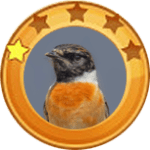- Home
- Shop
- Forest Series
- Grassland Series
- Desert Series
- Contact
- Home
- Shop
- Forest Series
- Grassland Series
- Desert Series
- Contact

Saxicola Series





Ideal Present for Children
Officially authorized by BENTLEY, this children’s ride-on is elaborately scaled down in accordance to the appearance of BENTLEY super-car with almost every detail of the bodywork preserved, such as the LED lights and the hydraulic supported lockable side doors. Molded with premium PP material, the body of this toy vehicle is glossy and realistic, sturdy and durable.
Handy and Comfortable
Just press on the red button on the right of the operating panel, the power will be on with simultaneous sound of engine. Benefited from the soft start setting, the acceleration of this toy vehicle is not violent, which ensures your child would not be shocked by uncomfortable feel caused by sudden change of speed.
Secure Driving
This toy vehicle could be manually operated by children as well as taken over the control by parents with the attached remote controller. Configured with an ergonomic seat and the 3-point safety belt, this toy could fix your child solidly onto the seat and effectively prevent the danger of falling off the car or hitting on the steering wheel during driving.
Abundant Recreation
Except the backlight for the dash board and volume adjusting, this children’s toy car has an easy access to rich audio resources through its TF card slot, 3.5mm AUX input and USB interface, adding much extra joy and relaxation for the driving experience in English-learning mode, story-telling mode and nursery rhyme singing mode, which could be manipulated by the two buttons on the steering wheel.


CHARACTERISTICS
The Chipmunk is a member of the family Mammalia, Rodentia and Sciuridae. It is also known as the Striped Squirrel, the Timber Tiger and the Mini-bear. The body length among most Chipmunks ranges from 5.5 to 6.3 inches and the tail length is 5 Inches. Chipmunks typically weigh about 0.02 pounds and live about 5 to 10 years. They have small but prominent ears which face forwards, and small eyes on the sides of their heads. Most wild Chipmunks are lively.


Lorem ipsum dolor sit amet, consectetur adipiscing elit. Ut elit tellus, luctus nec ullamcorper mattis, pulvinar dapibus leo.


CHARACTERISTICS
The African Stonechat is a species of the Old World flycatcher family. The male has a black head, trimmed with a white collar. The back and the wings are dark-brown and black. The upper breast is usually dark orange-red, with a sharp or gradual transition to white or pale orange on the lower breast and belly. The wings are short, because it only flies short distances. The female is much brighter than the male and has a dark-grey head. They are active little birds, only about 5″ long and weighing only about 26-37 lbs.

RANGE AND HABITAT
The African Stonechat is a widespread species that can be found over most of sub-Saharan Africa, occurring locally as far north as Senegal and Ethiopia. Outlying populations are found in the mountains of southwest Arabia and on Madagascar and Grande Comore. It is non-migratory, moving only locally if at all.

DIET
The African Stonechat drops to the ground from perch or hovers before dropping onto prey. It eats woodlice, snails, small earthworms, spiders, lizards, grasshoppers, bugs, ants, beetles, termites, lizards and small fish.

BEHAVIOR
The African Stonechat is usually seen in pairs. It usually likes to stand on the bush branches and the top branches of small trees, sometimes also stands in the field or roadside power lines and crops. Sometimes it stands still, watching the movement around him. If it encounters flying insects or sees insects on the ground, it immediately flies to catch them and then returns to its original place. Sometimes it also flaps its wings to stay in the air or does a straight up-and-down vertical flight.
The African Stonechat breeds in spring and summer. Females build their nests of grass and softer material in the shape of a deep cup, usually positioned on the ground at the base of a bush or other plant providing good cover. Clutches, containing up to 6 eggs, are incubated only by the female for two weeks, but both parents feed the chicks once they’ve hatched. Chicks leave the nest at about two weeks of age, and then stay with their parents for a further three weeks or so.

The Chipmunk is a member of the family Mammalia, Rodentia and Sciuridae. It is also known as the Striped Squirrel, the Timber Tiger and the Mini-bear. The body length among most Chipmunks ranges from 5.5 to 6.3 inches and the tail length is 5 inches. Chipmunks typically weigh about 0.02 pounds and live about 5 to 10 years. They have small but prominent ears which face forwards, small eyes on the sides of their heads. Most wild Chipmunks are lively.
The Red Squirrel, a member of the Sciuridae, is an arboreal, omnivorous rodent often referred to as a Forest Seeder and folklore as the Devil King Squirrel.
The Arizona Gray Squirrel, also known as the American Gray Squirrel, is a member of the family Rodentia and Sciuridae. It is small in size, with gray fur and a belly between white and cream. It has long ears, no tufts of fur and a fluffy tail edged in white. The body is about 16-20 inches long and weighs up to 1.4 pounds.
The Rock Squirrel, also known as Sao Maozi or Stone Mouse, belongs to the rodent and is a species in the family Sciuridae. The most common natural predators of the Rock Squirrel include bobcats, owls, eagles and snakes. Though the Rock Squirrel is cute, alert, and courageous, it is still considered a pest due to its habit of destroying crops.
The Abert’s Squirrel is a member of the genus Sciurus with a body length of 18-22.8 inches, a tail length of 7.5-9.8 inches and a weight of 2.2 pounds, and can live up to 10 years in the wild. Its most distinctive feature is tassels of fur about 0.8-1.2 inches long at the tip of its ears, which looks very interesting. In addition, it is alert and agile.

White-browed Bushchat: the Enigmatic Desert Dancer
Little is known about this elusive bird, including why it occasionally puffs its white breast feathers and sways gracefully from side to side, as if to an imagined melody
Rich and colourful, the Thar Desert is known for its traditional music and customary dances glorified in documentaries and Bollywood movies. However, what fascinates me more is the comical belly dance of a non-descriptive bird called white-browed bushchat, earlier known as Stoliczka’s whinchat. It was named after its discoverer Ferdinand Stoliczka, who was an ornithologist, geologist and explorer.
It was first described by Stoliczka in 1872 from a specimen collected in Rapar in Kutch, and named Pratincola macrorhyncha. Later it was named Stoliczka’s whinchat Saxicola macrorhyncha. In 2004, BirdLife International changed its name yet again to white-browed bushchat as it has conspicuous white-brows, more noticeable during the breeding season in the male. Recent DNA studies have created a great upheaval in taxonomy. Previously related species are now considered unrelated, and unrelated species are now considered to belong to one group. For instance, the white-browed bushchat does not belong to Pratincola but to Saxicola, old world flycatchers.
Leaving aside the taxonomy to experts, what attracted my attention to this relatively unknown bird in the early 1990s was that practically nothing is known about this species. Consulting the magnum opus of Indian ornithology, 10-volume Handbook of the Birds of India and Pakistan, by Dr Salim Ali and Dr Dillon Ripley revealed that it is found in the Thar Desert and nearby drier areas of Punjab, Haryana and western Uttar Pradesh. The book specifically mentions Aligarh, where I was teaching from 1992 to 1997. Aligarh has some drier areas so we went out looking for this bird, but found none. What further arose my curiosity that I had conducted many surveys in the Thar Desert in 1980s but never came across this bird. In 1992, my friend, Dr T.J. Roberts mentioned in his book Birds of Pakistan that Stoliczka’s whinchat is extinct in Pakistan as he could not find any during 28 years of field work. Why would a small, bulbul-sized elusive bird become extinct when it is not trapped for trade, hunted for food, and when its habitat has not changed much. Quick correspondence with International Council of Bird Preservation (now called BirdLife International) and Oriental Bird Club (OBC), UK brought the good news that Dutch ornithologists had photographed it near Khara, a village between Phalodi and Jaisalmer.
I had gone through this village many times during my surveys of the Great Indian Bustard but I had not noticed it (I was mainly concentrating on my work on the bustard). With the support of OBC, Cygnus Wildlife Holidays, and WWF-India, I decided to uncover the mystery of this ‘extinct’ bird. The first survey of three weeks in 1993 revealed four birds between Undu and Kanasar in Jaisalmer and Barmer districts. None seen in Gujarat, and even Rapar where the first specimen was collected, 120 years ago. In the second survey in the same year, only one could be seen in four weeks. While the third survey in January-February 1994 brought the bonanza: we saw about 81 individuals in 15 different sites in Rajasthan. Once my papers and articles were published, many more people got interested and now its presence has been recorded in Sultanpur Bird Sanctuary, and Hissar in Haryana, Naliya in Kutch, Velavadar, Little Rann of Kutch, Desert National Park in Jaisalmer and Barmer, Diyatra in Bikaner; Keoladeo National Park in Bharatpur; Khichan in Jodhpur; Ranthambore in Sawai Madhopur; Sonkhilya in Ajmer and Talchappar in Churu. It is also reported from Akola and near Pune, Maharashtra. When I started the work on this species, there was not even a good picture, but now we have a surfeit of images, thanks to the long-lensers always looking for rarity. The portal eBird has 278 records, many repeated from the same sites by different birdwatchers.
While studying this bird, I noticed an interesting behaviour — it does a puff-and-roll dance while it is foraging on the ground. It does not appear to be related to aggression or territoriality. While on the ground looking for insects, the bird puffs up the breast feathers and sways sideways. The whitish breast and white belly become conspicuous and the bird appears larger than normal. I recorded such a behaviour always on the ground while the bird was foraging, Nikhil Devasar, a very competent birdwatcher, saw a female ‘puffing’ from a high perch when he first approached her for a photograph. We still do not know the purpose of this puff-and-roll display. Is it to startle the insect prey? But why would it do this when the bird has already seen a prey from its perch. Like most members of Saxicola, the white-browed bushchat perches on a small bush and looks all around. When a prey is sighted, it descends and picks it up, but sometimes it does this puffing dance. It is an interesting topic for young researchers to study. Another curious behaviour that I noticed is that some individuals are quite bold and allow you to approach close (5-10 m), while others will fly away from 50-100 m.
Despite some research it is still a mystery bird to me. We do not know where it nests, how many eggs it lays, where it goes in certain seasons, and what are its ecological requirements. Its cousin white-throated bushchat Saxicola insignis breeds in a small area in Mongolia and Russia and migrates in small numbers to north India, Nepal Terai, Northeast India and Myanmar. The white-browed bushchat is not seen throughout the year. I wonder whether it also migrates to India from some unknown areas of Russia or Mongolia?
Fortunately, we now have geolocators and GSM-based systems for tracking small birds. I hope some researcher shows the inclination to study this enigmatic bird of India. Like the white-browed bushchat, there are many more species that need detailed study. Is anyone listening?



Follow Us: